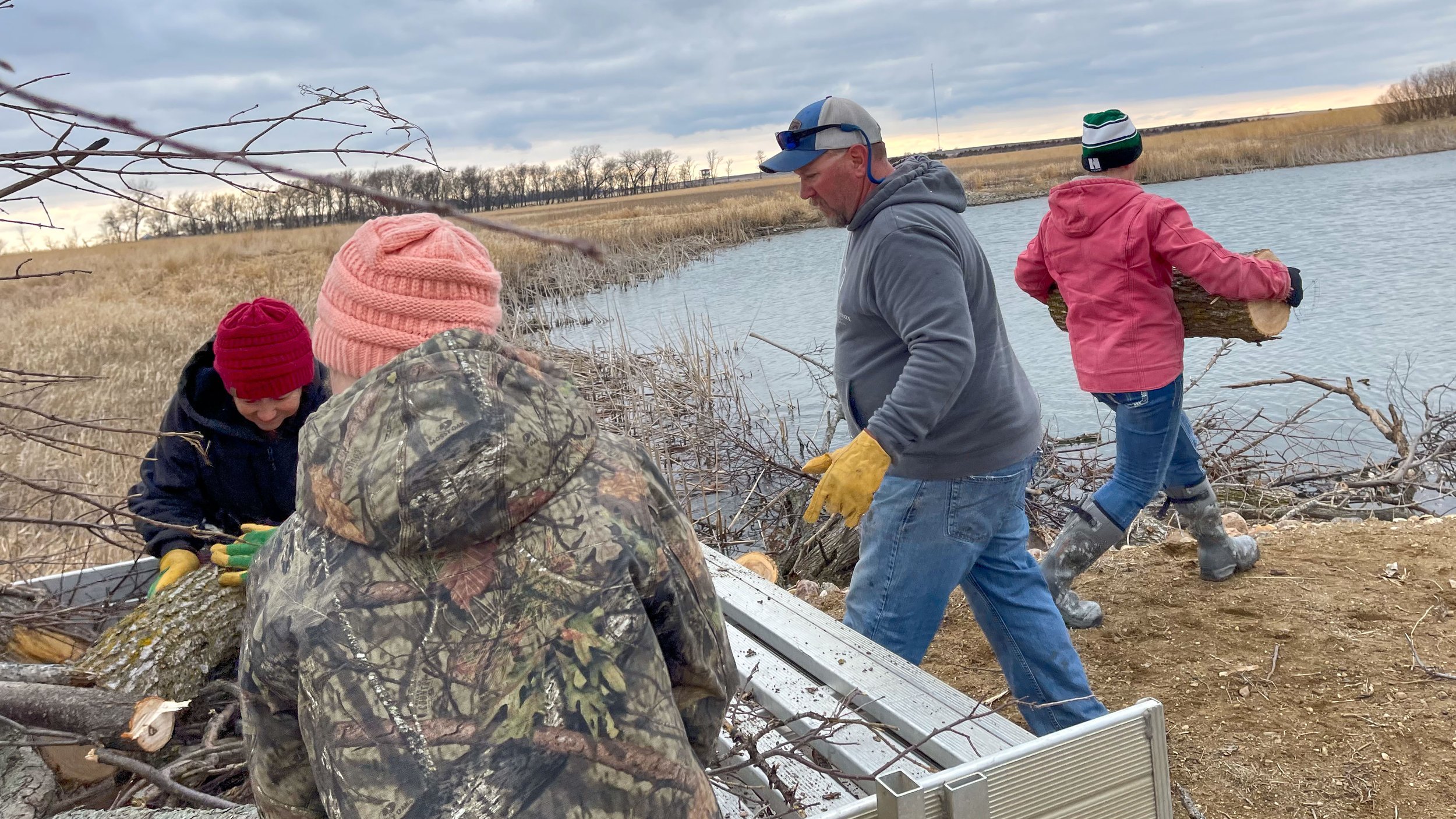Spring Family Workday: Cleanup & Habitat
Family Time
Brian and I believe very strongly in prioritizing family time, and we protect our scarce family time fiercely. It’s easy to spend 7 days a week on our computers and in our trucks meeting clients and working on their properties. It’s also easy to get caught in the trap of too many kids’ activities that splinter the family into 3 different directions and exhaust everyone with little to show for the time and money invested. Time outside, especially when we’re all working together, is what we think is the best possible way to be together. On our demonstration property, Blue Wing Ranch, in Clark County, South Dakota, there are many opportunities for working together outdoors. This is a story of a recent Sunday afternoon that we spent clearing downed trees from our shelter belt and adding habitat to our pond.
Think Spring
Spring is great time to clean up trees and limbs before leaf-out and also a great time to add new habitat to a pond. Winter weather including high winds, ice storms, and drifting snows all can cause damage to trees and shrubs that leave broken limbs and felled trees in a shelter belt. If left where they fall, they are unsightly and can create hideouts for predators. Of course everyone has different management goals for their property and different preferences for appearance. There is no single one right way to tend your land. Our preference is for relatively clean sight-lines down the rows of our shelter-belts.
Instead of a Bonfire, Spark Your Pond’s Metabolism
Complex tree trunks, rootwads, limbs, and branches, especially branches with lots of small shoots, create fantastic, even if short-lived, habitats for predators and prey. We’ve long known that habitat attracts predators, but a less-known benefit of habitat is as a stimulant to the whole pond ecosystem. The tree parts provide a place for algae and bacteria to attach and grow. Soon, aquatic insects graze on this film, and smaller bodied fishes key in to feed on those insects. Larger bodied fishes feed on the smaller bodied fishes, and through this obscure chain of energy transfer, the productivity of the pond increase, just because a new place to grow in the light was added.
Everyone Can Help
Admittedly, we are a little more willing than most to let our kids try things that might not be recommended for their age by the manufacturer. When we think they’re ready, we teach them how to use tools and heavy equipment. On a project like this, there are many small and large pieces of trees to be picked up, moved to the pond and thrown in. Our youngest daughter is currently 4, and she was able to drag branches that were 2-3 inches in diameter and up to 15 feet long. Little kids really like to have a job to do, and be valued, just like adults, so we say let them help! Our teenage daughters (13 and 14 years old) are getting really strong, and so it was important to remind them about healthy lifting techniques like squatting and using their legs rather than bending at the waist and straining their backs. Grandma also enjoyed the fresh air and exercise of the project. Brian mainly ran the chainsaw on this day, and I maneuvered the trailer around.
Right Tools for the Job
This project does not require lots of expensive or specialized equipment. We made sure everyone had gloves, dressed in layers, and wore good shoes or boots. If you have a brush mower like we do, you know how handy they are for wiping out the small new growth of buck brush and other obnoxious woodies that can quickly take over a shelter belt. Ours will take down up to about 4 inch diameter stems. A claw bucket for the skid steer would be super handy, especially if you’re working alone, but it is not necessary when you put the whole family on the job. One essential tool is a chainsaw. After years of fighting a gas model, we’ve largely made the switch to a battery powered saw, and it is surprisingly powerful for its size and weight. We piled the branches on our utility trailer, connected to our SUV.
Scope of Work
We repeat this job every spring. Clean up of the shelter belt is needed every year, and the pond habitat breaks down surprisingly quickly. For reference, cedar trees only provide functional pond habitat for 3-5 years. Most of the tree parts that we are clearing from our shelter belts are from species that are much softer (read: break down faster), such as Green Ash and Cottonwood. If you have a half day to invest or a week, this is a job that can be started and stopped to accommodate the time available and your family’s busy schedule. We spent about 4 hours working on this particular day, and we moved about 3 trailer loads of brush piles to the pond. To get the most bang for your buck, try to make a log jam of the brush pile. You don’t want the pieces evenly distributed–you want them stacked on top of one another. Check out our YouTube channel and follow us on Instagram and Facebook for fisheries science and how-to’s.
Katie Graeb, PhD
Blue Wing Outdoors






